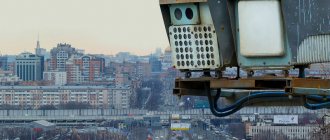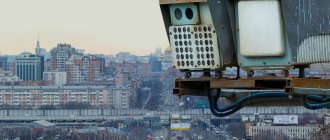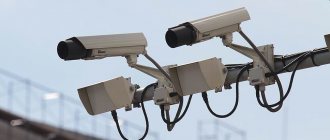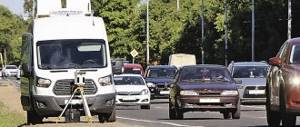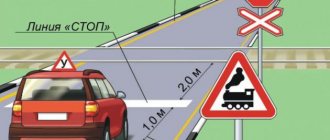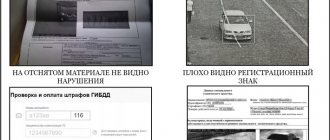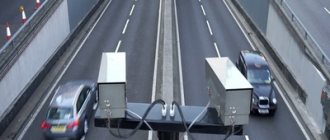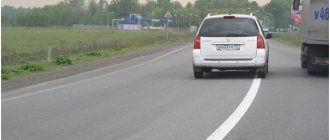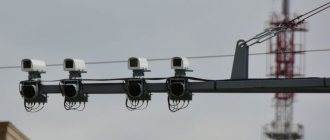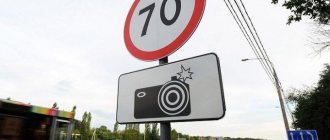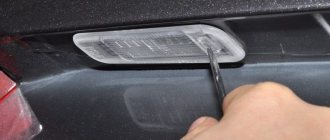Video cameras for recording traffic violations are designed to operate automatically around the clock. However, some motorists note that they often drive over the speed limit at night, but do not receive chain letters. Does this mean that video cameras do not work at night or are not able to see the violation and “identify” your car?
How do CCTV cameras work at night?
As an argument that traffic police video cameras work at night and see worse, soldiers often mention that the equipment is installed exclusively on illuminated sections of roads. Is it so?
Truly modern video recording cameras are very sensitive video equipment that operates in continuous tracking mode, can overheat in the sun and partially lose “vision” in heavy fog, rain or snowfall. However, they do not turn off at night and see disturbances even in the dark.
The radar-type camera operates according to a complex algorithm:
- emits a Doppler signal over a distance of up to 1000 meters, with the help of which it records the speed at which the car is moving;
- then emits an infrared signal that scans the car's license plate;
- transmits the data packet to the software package, which processes the received data.
Since the traffic police violator must be provided with a photograph of his car in the “letter of happiness” with the headlights on and a clearly readable license plate number, light is needed on a controlled section of the road to photograph the car. That's why cameras are installed on illuminated sections of the road - this allows you to reduce the level of errors and get clear pictures of the car.
“Dirt can confuse the cameras.” How to recognize unreadable license plates
Photo: Mos.ru
“Dirt can confuse cameras because their vision is very similar to that of humans,” Laskin explained. - So, the camera sees a number, a certain associative series is created, a decision is made that the number looks like 8, but it is actually 0 with a lump of dirt in the middle. Therefore, in our cameras the algorithm is as follows: if the device recognizes the number, but the probability of error is higher than 20%, this data simply goes into the stream, for example, to collect statistical data or for investigative activities. They simply won’t get to the processing centers: materials for fines are generated only with 99% confidence.”
Car services Autonews
No need to search anymore. We guarantee quality of services. Always nearby.
Select service
The expert admits that the problem of driving with dirty license plates is acute and so far it is not possible to record all violations using cameras. The progressive technologies that were proposed to be introduced when creating license plates have not yet justified themselves. For example, the idea of installing special chips in rooms did not go beyond the discussion stage. For this reason, traffic police officers regularly conduct raids and require drivers to remove snow and dirt from signs. According to Laskin, the issue of dirty signs will be finally resolved only when cameras are replaced by radio imagers capable of reading license plates.
Artificial intelligence understands everything
In turn, representative () Sergey Kusov assures that the cameras can read even dirty signs, albeit with certain restrictions. But data collected using artificial intelligence cannot be used as an evidence base. The information is not suitable for issuing fines, since cameras sometimes, like a mosaic, piece by piece collect data about the vehicle’s license plate along its entire route. On this basis, artificial intelligence concludes what license plate the car has, but it is not possible to take clear photographs showing the moment of the violation.
As an example, the expert cited the situation with recording systems that measure the average speed of cars in a separate area. Thus, all working cameras take turns recording the license plate number of the offending vehicle. If it is contaminated, artificial intelligence still analyzes each image, compares them with databases, collects them into a single picture and thus “understands” what the number is. The camera determines that a particular car has violated traffic rules, and artificial intelligence “completes” information about the license plate for it.
Difference in camera operating modes day and night
But the camera is capable of detecting speed limit violations and identifying license plate numbers even in complete darkness: it performs recognition using infrared illumination, which is invisible to the human eye and does not require additional lighting.
At night, the video recording camera switches on the infrared illumination mode. During the day it is not needed: the camera lens is able to read the car license plate on its own, so the IR illuminator is removed with a special filter, or is completely turned off from the control panel.
It is difficult to see the operation of the infrared illumination, but in the dark you can see it on the camera body: during operation, the IR diode heats up and emits a thermal red glow, visible to the eye. Sometimes, when the diode overheats, the backlight can turn off spontaneously, and you have a chance to drive under the camera unidentified. But there is a risk: in new models of video cameras they have learned to hide the IR illuminator eye (it can also operate at a frequency of 940 nm, invisible to the eye).
Thus, you should not hope that you are “invisible” on the road at night - video recording cameras work around the clock and record traffic violations with almost the same accuracy as they do in daylight. The use of infrared illumination allows the equipment to remain “sighted” even in complete darkness.
What should you consider? That at night, in poor lighting and poor visibility (fog, snow and rain), video recording errors are higher, and if the IR illumination overheats, it may turn off, which will not allow you to determine the license plate number of your car. However, the likelihood of slipping through “unrecognized”, especially in the city, is extremely low. Therefore, it is better not to violate traffic rules either day or night, and not to try to check whether the video camera can clearly see you on the road.
“At night the cameras in Moscow are already turned off”
Dedicated lanes for public transport, paid parking to the Garden Ring - these measures, unpopular among the people, remind the Moscow authorities, are aimed at improving the transport situation in the capital. And if it seems that the capital really cannot survive during the day without such restrictions, then why not lift these bans at night or in the event of huge congestion? An Autonews.ru correspondent asked the experts with this question. "Dedicated" one for everyone
After almost three years, we can firmly say that dedicated lanes immediately changed the capital’s traffic.
While city authorities are reporting an increase in the average speed of buses and trolleybuses, ordinary motorists and experts note that traffic jams have only become worse with the advent of dedicated buses. After a year and a half of experiments on citizens, the authorities still allowed them to travel on public transport lanes on weekends. Cameras monitoring vehicles on the “dedicated” line are turned off at midnight from Friday to Saturday and turned on again at midnight from Sunday to Monday. However, many experts are confident that it is possible to use the dedicated parking lot more often. The cameras are turned off at 00:00 on Saturday and turned on at 00:00 on Monday.
“The simplest regulation of this issue is to install a traffic light above each such lane, like those installed on reversible lanes. Which will light up either green or red, indicating whether you can or cannot drive,” says Alexander Shumsky, head of the Probok.net expert center.
“Nothing prevents us from allowing people to drive and park there for free at night. In addition to the position of the city leadership. Their motives are unknown to me, to be honest,” Petr Shkumatov, coordinator of the Blue Buckets project, expressed his opinion to the Autonews.ru correspondent.
However, the authorities seem to be preparing for a dialogue with motorists. In any case, the scientific director of the Research Institute of Transport and Road Management, Mikhail Blinkin, in an interview with Autonews.ru, said that regulating traffic on weekends and at night is included in the direct plans of the Department of Transport, and they promise to find a solution acceptable to residents soon.
If the city decides to install traffic lights above the public transport lanes, the effect of this measure will be noticeable immediately, Alexander Shumsky is sure. According to the expert, this solution has already been tested in many Western countries and allows for a quick response to emergency situations on the road. In addition, with the advent of traffic light regulation on dedicated roads, the time range of their use becomes unlimited.
The simplest solution is to install traffic lights above the allocated areas.
“This measure will be very effective at 22-23. For example, there are still congestions on Andropov Avenue at this time, but the movement of public transport into the region is not so intense. If we allow motorists into this lane, then there will be no traffic jam as such, and public transport will not feel any worse, and private transport will go much faster. Therefore, this is a question not only of night, but also of evening and morning traffic regulation,” says the head of the Probok.net expert center.
On the other hand, the temporary use of “dedicated areas” to combat traffic jams will be a step backwards, Mikhail Blinkin insists. Lanes for public transport were not created at all in order to then allow ordinary motorists back into them, he believes.
“When it comes to public transport, a congestion has begun on the road - and someone suggests allowing a flow of personal transport into the “dedicated lane” - this situation is exactly the opposite of all world experience. We allocate a public transport lane where, according to science, in an hour, let’s say, I can carry more passengers on a bus than people transport their dear ones in their cars. This is a simple technical condition. For example, I have a three-minute interval. There are 20 buses carrying 80 passengers per hour, a total of 1600! No lane of cars will ever carry such a number of passengers. Physically. Therefore, gentlemen motorists are not allowed here. If we have a low-intensity route, few buses, trolleybuses, and more people travel by car, then in such a place this lane is simply not needed,” the expert argues for his position.
“This is a question not only of night, but also of evening and morning traffic regulation.”
The chaotic use of dedicated lanes will not lead to anything good; motorists will start driving along them and at red traffic lights. However, Mikhail Blinkin does not see anything criminal in allowing car owners into public transport lanes in the evening and at night. But this must be done taking into account foreign experience.
“There is world practice. Signs “Only bus line” with a sign indicating the conditions: at such and such hours, on weekdays. Such signs, by the way, do not contradict the rules for arranging city streets. We will certainly come to this practice. We are just learning how to use public transport lanes,” noted the scientific director of the Research Institute of Transport and Road Facilities.
80 during the day, free at night
As of December 5, we would like to remind you that the paid parking zone in Moscow is increasing to the Garden Ring. At the same time, the cost of an hour of parking within the Boulevard Ring will increase from 50 to 80 rubles. Parking a car closer to Sadovoy will cost 60 rubles per hour.
Deputy Mayor of Moscow and head of the capital's transport department Maxim Liksutov believes that the increase in tariffs will rid the center of Moscow of random transport. “With the expansion of the paid parking zone, the linear tariff - 50 rubles - does not look correct. In areas that are most in demand and do not concern social facilities, there should be differentiation of tariffs,” Liksutov noted.
Mikhail Blinkin has no doubt that parking closer to the Kremlin or business centers should cost more than on other streets. And 80 rubles per hour, in his opinion, is not the final figure at all. The market itself will determine the tariffs, he is sure.
According to many, the paid parking zone is turning into a tool for making money.
“After some time, with normal tariffs, it will turn out that a significant part of Muscovites have stopped driving cars. If this does not happen, then it will be necessary to raise parking prices further. For example, the Kremlin is more expensive, closer to the Garden Ring it is cheaper. Not a single city in the world could live without such measures,” says Blinken.
Rising parking prices have caused a wave of discontent among motorists. According to many, the initially regulatory measure is becoming more and more like a tool for making money.
Partial compensation for increased costs may be the abolition of paid parking at night, as well as on weekends and holidays. The head of the capital's transport department, Maxim Liskutov, said that city authorities are already considering this possibility. However, only Muscovites will be allowed to park for free. “We are now talking about making parking on Sunday free of charge for Moscow residents who are registered on the website parking.mos.ru from December 25. This is done in order to promptly contact the owner of the car in case the car is towed or is obstructing the passage,” Alexander Shumsky, head of the Probok.net expert center, told an Autonews.ru correspondent.
They still don’t charge money for parking at night.
According to the expert, this measure is formal, and, rather, represents a message from the authorities to the townspeople: “We are already meeting you halfway.” If it is reported that only Moscow motorists will not be charged money for parking on weekends, then it is logical to assume that everyone else will be charged. If we talk about parking not on weekends, but at night, then so far, in fact, no one is charged for them.
“Today, in fact, no one takes money for parking at night - parking lots are open from 08:00 in the morning until 20:00 in the evening. At least for now,” notes Alexander Shumsky.
But this relaxation is not formally enshrined, and the conclusion suggests itself: if motorists are not given information about the opportunity to park for free at night (and this, obviously, would reduce the degree of protest), it means that they will soon be deprived of this opportunity.
Nobody knows yet what the city bill on relaxations regarding paid parking will look like in its final version. But, according to Alexander Shumsky, at night and in the evening there is no need to charge a fee for parking in the center at all. There are plenty of free places. Moreover, at this time there is no cost-commensurate alternative to personal transport.
“I think overnight parking should be free. Because the only way to leave the center at 2 am is by taxi. And there are no other ways - this is not very fair, because if people come for a walk, why can’t they park their car for free? Moreover, in the evening, almost all transport leaves the center,” the expert concluded.
Alexey Matveev
